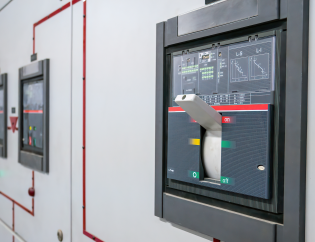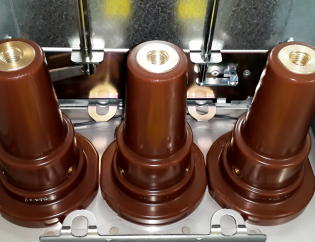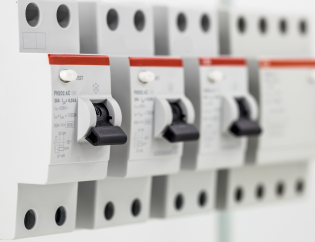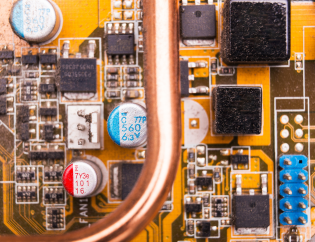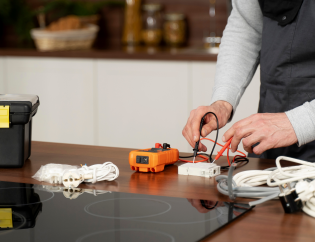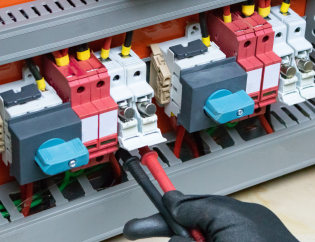On the other hand, oil-immersed transformers use oil as a coolant and insulation medium. Oil-immersed transformers are generally more efficient at dissipating heat than dry-type transformers, making them suitable for high-power applications. They are generally more rugged and have longer life spans than dry-type transformers.
What is a Dry-Type Transformer?
A dry-type transformer is a type of electrical transformer that does not use oil or any other liquid as a cooling or insulation medium. Instead, it uses air or another gas to dissipate heat generated during operation. Dry-type transformers are considered safer and more environmentally friendly compared to oil-immersed transformers as they do not pose a fire risk and do not release hazardous substances in the event of an oil spill. They are commonly used in indoor environments and can be found in applications such as power distribution, lighting, and industrial processes.
What is an Oil-Filled Transformer?
An oil-filled transformer is a type of electrical transformer that uses oil as a coolant and insulation medium. The oil helps to dissipate heat generated during operation while also providing electrical insulation between the windings and core of the transformer. Oil-filled transformers are commonly used in high-power applications where large amounts of heat need to be dissipated. They are also typically more rugged and have a longer life span than dry-type transformers. However, they pose a fire risk and release hazardous substances in the event of an oil spill, making them less suitable for indoor and environmentally sensitive applications.
Dry-Type Transformers Vs. Oil-Filled Transformers: Key Differences
Here are the key differences between dry-type and oil-filled transformers:
- Cooling and insulation medium: Dry-type transformers use air or another gas as a cooling medium, while oil-filled transformers use oil.
- Safety: Dry-type transformers are considered safer as they do not pose a fire risk or release hazardous substances in the event of an oil spill, unlike oil-filled transformers.
- Environment: Dry-type transformers are more environmentally friendly, as they do not release hazardous substances in the event of an oil spill.
- Location: Dry-type transformers are commonly used in indoor environments, while oil-filled transformers are typically used in outdoor or industrial environments.
- Efficiency: Oil-filled transformers are generally more efficient at dissipating heat, making them suitable for high-power applications.
- Life span: Oil-filled transformers typically have a longer life span compared to dry-type transformers.
- Cost: Dry-type transformers are generally less expensive than oil-filled transformers.
- Maintenance: Oil-filled transformers require regular maintenance, including checking oil levels and monitoring for signs of degradation, while dry-type transformers typically require less maintenance.
Types of Dry-Type Transformers
- Cast Resin Dry-Type Transformers: These transformers use cast resin material to encase the windings and core, providing insulation and protection from the environment.
- Air-Cooled Dry-Type Transformers: These transformers use air as the cooling medium to dissipate heat generated during operation.
- Dry-Type Auto Transformers: These transformers use a single winding to provide voltage transformation rather than multiple windings like conventional transformers.
- Dry-Type Isolation Transformers: These transformers are used to isolate electrical circuits, providing protection against electrical noise and power fluctuations.
- Dry-Type Distributed Transformers: These transformers are designed for use in decentralized power distribution systems and are used to supply power to small loads at the point of use.
Types of Oil-Filled Transformers
- Power Transformers: These transformers are used for high-power applications and are typically the largest type of oil-filled transformer.
- Distribution Transformers: These transformers are used to step down voltage levels for use in power distribution networks.
- Instrument Transformers: These transformers are used to measure electrical current and voltage levels in power distribution systems.
- Tap Changing Transformers: These transformers are equipped with a mechanism to change the voltage output, allowing for adjustments to be made to the power supply.
- Regulating Transformers: These transformers are equipped with a mechanism to regulate the voltage output, ensuring stable power supply conditions.
Benefits and Limitations of Dry Type & Oil Filled Transformers
Dry-type transformers and oil-filled transformers both have their own benefits and limitations.
Dry-type transformers are generally considered safer and more environmentally friendly than oil-filled transformers. They do not pose a fire risk and do not release hazardous substances in the event of an oil spill. Dry-type transformers are also commonly used in indoor environments and can be found in applications such as power distribution, lighting, and industrial processes. In addition, dry-type transformers are typically less expensive and require less maintenance compared to oil-filled transformers.
However, the main limitation of dry-type transformers is their efficiency in dissipating heat. The air or gas used for cooling is less effective at removing heat compared to oil, making dry-type transformers less suitable for high-power applications.
On the other hand, oil-filled transformers are generally more efficient at dissipating heat, making them suitable for high-power applications. They are also typically more rugged and have a longer life span compared to dry-type transformers. However, oil-filled transformers pose a fire risk and release hazardous substances in the event of an oil spill, making them less suitable for indoor and environmentally sensitive applications. In addition, oil-filled transformers require regular maintenance, including checking oil levels and monitoring for signs of degradation.
In conclusion, the choice between dry-type and oil-filled transformers depends on the application’s specific requirements, including power requirements, environmental conditions, and safety considerations.
Conclusion
In conclusion, both dry-type and oil-filled transformers have their own benefits and limitations, and the choice between them depends on the application’s specific requirements. Dry-type transformers are considered safer and more environmentally friendly, while oil-filled transformers are more suitable for high-power applications. Both types of transformers are widely used in a variety of applications, including power distribution, lighting, industrial processes, and more. Ultimately, the choice between dry-type and oil-filled transformers will depend on factors such as power requirements, environmental conditions, safety considerations, cost, and maintenance requirements.
Choose the right transformer for your electrical needs. Contact ECSKSA today for expert advice and the top-quality dry type and oil-filled transformers.
FAQs
1. What are the benefits of dry-type transformers?
Dry-type transformers are considered safer and more environmentally friendly, as they do not pose a fire risk or release hazardous substances in the event of an oil spill. They are also commonly used in indoor environments and are less expensive and require less maintenance compared to oil-filled transformers.
2. What are the benefits of oil-filled transformers?
Oil-filled transformers are generally more efficient at dissipating heat, making them suitable for high-power applications. They are also typically more rugged and have a longer life span compared to dry-type transformers.
Do you have a question in your mind? If so, make sure to fill out the form below!




